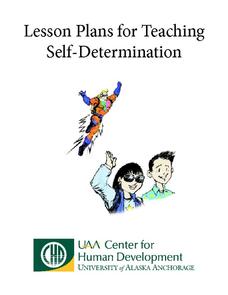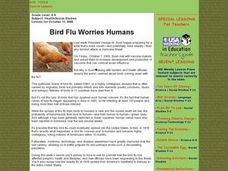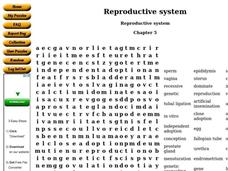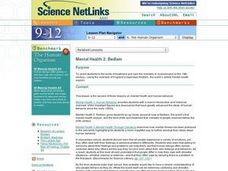Curated OER
Human Population's Response to Re-emerging and Emerging Infectious Diseases
Students examine the human population response to microbial diseases. In this disease lesson students observe population trends, write about a scientist and evaluate and defend current treatments for infectious diseases.
Curated OER
The Human Memory
This is a well-designed, creative lesson to help students learn more about the human memory. Working in pairs, students complete tasks and gather data. Excellent websites for resources are also provided.
Curated OER
Life Science: Human Body Skit
Learners create skits based on the human body systems. Working in groups, they role-play as organs in the various systems. They make costumes or wear signs identifying themselves as the organs in their skits.
University of Alaska
Lesson Plans for Teaching Self-Determination
How do we prepare kids, especially those with disabilities, for life after school, for the workplace, for independent living? This 96-page packet is loaded with self-assessment surveys, with skill builders, with information about rules,...
Curated OER
Bird Flu Worries Humans
Students examine what the bird flu is and how it spreads through an interactive program and videos. They discover why doctors are concerned about a pandemic. They examine other pandemics in the United States and how to prepare for them.
Global Oneness Project
Reclaiming Rivers
Robert Hass's article "Rivers and Stories" underscores the importance of rivers in the development of civilization and the importance of reclaiming supposedly dead rivers and implementing policies that protect river health. Groups...
Teach Engineering
Nanotechnology Grant Proposal Writing
Please, sir, can I have a few thousand dollars for my research? The last installment in a six-part lesson has the pupils develop a grant proposal. Class members apply their knowledge of skin cancer, ultraviolet radiation, human skin, and...
Council for the Curriculum, Examinations and Assessment
Safety and Managing Risk
Is it worth the risk? Class members examine a framework for assessing and managing risks and then apply the model to the provided scenarios. To conclude the session individuals apply the model to a personal situation and record their...
King Country
Lesson 22: Reproduction - Day 4: Sexual Decision-Making
This fourth instructional activity on sexual decision-making helps class members identify issues that should be considered before engaging in a sexual relationship. In addition, different types of sexual expression are discussed. The...
Twin Cities Medical Society
Should I Talk to My Kids about Vaping?
Enlist parents and guardians in an anti-vaping campaign with an infographic that offers suggestions for how to talk with their students about e-cigarettes and e-liquids. The visual includes information about the dangers of vaping as well...
Curated OER
Teaching Biology Through Bioinformatics
Wow! A very detailed slideshow covers complex topics of genome research methods. This is advanced and relevant to the highest level of school biology. Excellent resource if you wish to expose your class to scientific methods and...
Baylor College
Plant Parts You Eat
Plants provide a variety of delicious foods essential for human survival. In the fourth lesson of this series on food science, young scientists investigate common fruits, vegetables, and grains in order to determine which plant part is...
Polar Trec
Calorimetry Lab
Young people between the ages of 11–13 need on average about 2,000 calories per day. Within the lab, groups learn about calorimetry and respiration. They explore how it pertains to humans and animals living the Arctic where cold...
Curated OER
Home: Where the Heart Is
If you're looking for copious background information to support study of the human heart, here it is! You can find photos of hearts, and text about the development, structure, systems, and monitoring that support heart function. Also...
Curated OER
What Do Drugs Do to the Body?
Students research the effects that drugs have on the human body. Using this information, they create a poster showing some of the effects of a specific drug. They work together to summarize the information they have gathered and present...
Curated OER
HIV Prevention
Seventh graders engage in critical thinking skills about personal health and safety to prevent the acquiring of the HIV disease. The project is an extension of this thinking designed for students to think about all the different ways...
Curated OER
Food Safety-Consumers Need the Facts
Students begin by completing a survey asking them to rank their concerns about commercially prepared foods. They develop a definition of relative risk, and complete the "Pro or Con" worksheet. Students work in groups to make a study of...
Curated OER
Reproductive System
For this biology worksheet, students find the terms that are related to the human reproductive system and the answers are found at the bottom of the page.
Curated OER
Mental Health 2: Bedlam
Students are oriented to the kinds of treatment and care the mentally ill received prior to the 19th century-using the example of England's legendary Bedlam, the world's oldest mental health asylum.
Texas Center for Learning Disabilities
Second and Third Grade Explicit Phonics Intervention
Support all young learners on their journey to literacy with this five-lesson reading intervention unit. Following a clearly outlined format, each lesson first engages children in practicing their phonemic awareness and phonics...
University of Texas
What Are Calories?
What are calories, and how do calorie needs differ from person to person? Here is a worksheet that briefly explains how calories measure the energy supplied by food, as well as suggests the amount of food an individual should eat per day.
Swiss Agency for Development and Cooperation
Gender and Sport
Serena Williams, Mia Hamm, and Danica Patrick are living proof that women enjoy sports just as much as men. Sports enthusiasts read about the importance of gender equality on the playing field. They discover barriers to participation and...
Scholastic
Marijuana: Perception of Harm vs. Use
Many teenagers don't believe that marijuana is harmful, but if they do, it affects whether they use it or not. Analyze the relationship between what high school seniors believe about marijuana and their tendency to use it with a reading...
National Center for Case Study Teaching in Science
In Sickness and in Health
Based on family history, how likely is it that a couple's children will have a recessive disease? In an in-depth, but easy-to-follow case study, future geneticists learn the story of Greg and Olga, who are hoping to have children, but...























